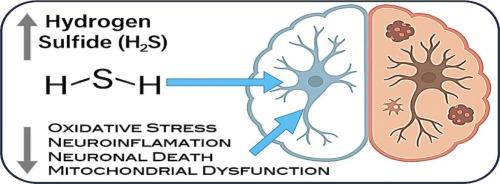Hydrogen sulfide in the brain as a silent neuroprotector in Alzheimer’s disease
IF 2.8
3区 医学
Q2 NEUROSCIENCES
引用次数: 0
Abstract
Hydrogen sulfide (H2S) is an endogenously produced gasotransmitter that has garnered growing attention for its critical roles in cellular signalling and brain function. It regulates NMDA receptors during long-term potentiation, a fundamental mechanism underlying memory consolidation and influences neurotransmission and essential neurophysiological functions. H2S is synthesized by three enzymes: cystathionine γ-lyase (CSE) and cystathionine β-synthase (CBS) and 3-mercaptopyruvate sulfurtransferase (MST) within the cell. CBS is suggested to be the primary source of H2S in the brain parenchyma, while CSE and MST predominantly contribute to its production in cerebral microvessels and astrocytes, respectively. This gasotransmitter plays a pivotal role in modulating hippocampal memory formation, reducing inflammation, promoting vasorelaxation, and supporting angiogenesis. It has been suggested to act as a second messenger or neurotransmitter in the brain, typically activated by neuronal excitation. H2S has been widely investigated for its therapeutic potential in Alzheimer’s disease. Notably, Alzheimer’s disease patients display significantly diminished levels of H2S compared to age matched subjects. This review offers a consolidated and updated role of H2S in Alzheimer’s disease, emphasizing recent mechanistic advances not covered in earlier literature. The work presents a novel perspective by integrating emerging findings on H2S based neurotherapeutic strategies.

大脑中的硫化氢作为阿尔茨海默病的无声神经保护器。
硫化氢(H2S)是一种内源性气体递质,因其在细胞信号传导和脑功能中的重要作用而受到越来越多的关注。它在长时程增强过程中调节NMDA受体,这是记忆巩固的基本机制,并影响神经传递和基本神经生理功能。H2S在细胞内由半胱硫氨酸γ-裂解酶(CSE)、半胱硫氨酸β-合成酶(CBS)和3-巯基丙酮酸硫转移酶(MST)三种酶合成。CBS是脑实质中H2S的主要来源,而CSE和MST分别在脑微血管和星形胶质细胞中主要产生H2S。这种气体递质在调节海马记忆形成、减少炎症、促进血管松弛和支持血管生成中起关键作用。它被认为是大脑中的第二信使或神经递质,通常由神经元兴奋激活。H2S因其治疗阿尔茨海默病的潜力而被广泛研究。值得注意的是,与年龄匹配的受试者相比,阿尔茨海默病患者的H2S水平明显降低。这篇综述提供了H2S在阿尔茨海默病中的巩固和更新的作用,强调了早期文献中未涉及的最新机制进展。这项工作通过整合基于H2S的神经治疗策略的新发现,提出了一个新的视角。
本文章由计算机程序翻译,如有差异,请以英文原文为准。
求助全文
约1分钟内获得全文
求助全文
来源期刊

Neuroscience
医学-神经科学
CiteScore
6.20
自引率
0.00%
发文量
394
审稿时长
52 days
期刊介绍:
Neuroscience publishes papers describing the results of original research on any aspect of the scientific study of the nervous system. Any paper, however short, will be considered for publication provided that it reports significant, new and carefully confirmed findings with full experimental details.
 求助内容:
求助内容: 应助结果提醒方式:
应助结果提醒方式:


